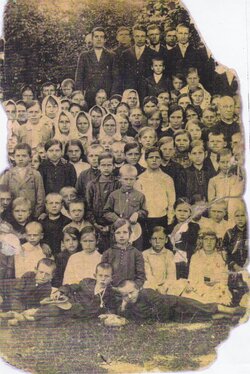Photo Gallery
-
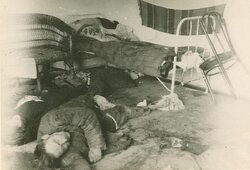 (photo No. 2) A photo from an investigation conducted by the IPN branch in Lublin regarding Volhynia
(photo No. 2) A photo from an investigation conducted by the IPN branch in Lublin regarding Volhynia
-
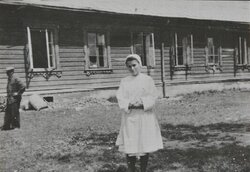 The Polish Red Cross shelter in Chełm. Photo No. 1. During the occupation it functioned as a hospital for the Polish population and it sheltered refugees from Volhynia in 1943. Chełm Museum collection.
The Polish Red Cross shelter in Chełm. Photo No. 1. During the occupation it functioned as a hospital for the Polish population and it sheltered refugees from Volhynia in 1943. Chełm Museum collection.
-
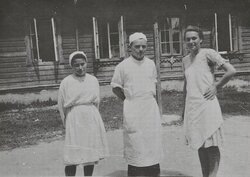 The Polish Red Cross shelter in Chełm. Photo No. 2. During the occupation it functioned as a hospital for the Polish population and it sheltered refugees from Volhynia in 1943. Chełm Museum collection.
The Polish Red Cross shelter in Chełm. Photo No. 2. During the occupation it functioned as a hospital for the Polish population and it sheltered refugees from Volhynia in 1943. Chełm Museum collection.
-
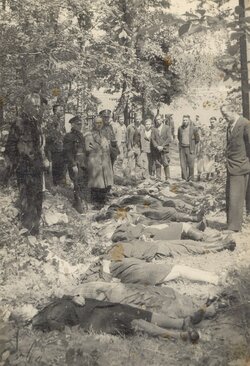 Victims of the UPA attack on a train conducted on June 16, 1944 near Zatyl (vicinity of Lubycza Królewska). IPN collection.
Victims of the UPA attack on a train conducted on June 16, 1944 near Zatyl (vicinity of Lubycza Królewska). IPN collection.
-
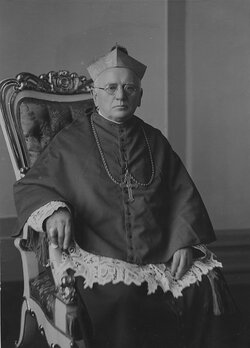 Bolesław Twardowski Portrait of the Lvov Metropolitan Archbishop (Latin rite).
Bolesław Twardowski Portrait of the Lvov Metropolitan Archbishop (Latin rite).
-
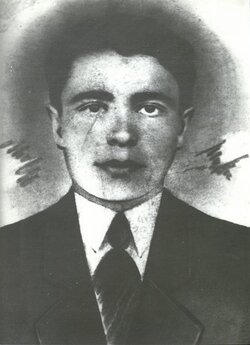 A man murdered on July 11, 1943 in Witoldów. Materials from the files of an investigation conducted by the Lublin Branch of the Commission for the Prosecution of Crimes against the Polish Nation regarding the 1943 attacks of Ukrainian nationalists on Polish citizens in Witoldów in Volhynia.
A man murdered on July 11, 1943 in Witoldów. Materials from the files of an investigation conducted by the Lublin Branch of the Commission for the Prosecution of Crimes against the Polish Nation regarding the 1943 attacks of Ukrainian nationalists on Polish citizens in Witoldów in Volhynia.
-
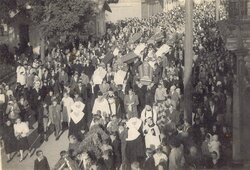 Victims of a UPA attack on a train conducted on June 16, 1944 near Zatyl (vicinity of Lubycza Królewska). Regional Museum in Tomaszów Lubelski.
Victims of a UPA attack on a train conducted on June 16, 1944 near Zatyl (vicinity of Lubycza Królewska). Regional Museum in Tomaszów Lubelski.
-
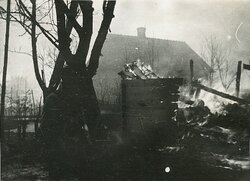 Sahryń, March 10, 1944, retaliation attack of the Tomaszów Lubelski AK Region on Ukrainian inhabitants of the village. Regional Museum in Tomaszów Lubelski. Photo No. 1.
Sahryń, March 10, 1944, retaliation attack of the Tomaszów Lubelski AK Region on Ukrainian inhabitants of the village. Regional Museum in Tomaszów Lubelski. Photo No. 1.
-
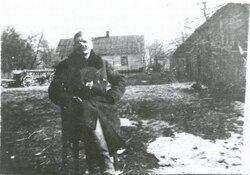 Konstanty Stankiewicz murdered on June 11, 1943 in Włodzimierz Wołyński county. Documents from the files of an investigation conducted by the Lublin Branch of the Commission for the Prosecution of Crimes against the Polish Nation regarding the 1943 massacres.
Konstanty Stankiewicz murdered on June 11, 1943 in Włodzimierz Wołyński county. Documents from the files of an investigation conducted by the Lublin Branch of the Commission for the Prosecution of Crimes against the Polish Nation regarding the 1943 massacres.
-
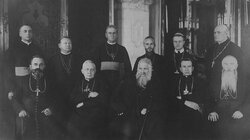 Convention of Unite bishops, Lvov, 1927. Standing from left to right: the apostolski Administrator of the Preszów eparchy Bishop Dionýz Njarady, the Greek Catholic Stanisławów Bishop Grzegorz Chomyszyn, the Lvov Archbishop Andrzej Szeptycki, Bishop Nicetas Budka from Canada, and Przemyśl Bishop Jozafat Kocyłowski. Among the standing clergymen: General Curate Józef Hanula from the USA, Bishop Vasyl Takach from the USA, Bishop Piotr Hebej from Czechoslovakia, and General Curate Aleksander Baczyński from Lvov.
Convention of Unite bishops, Lvov, 1927. Standing from left to right: the apostolski Administrator of the Preszów eparchy Bishop Dionýz Njarady, the Greek Catholic Stanisławów Bishop Grzegorz Chomyszyn, the Lvov Archbishop Andrzej Szeptycki, Bishop Nicetas Budka from Canada, and Przemyśl Bishop Jozafat Kocyłowski. Among the standing clergymen: General Curate Józef Hanula from the USA, Bishop Vasyl Takach from the USA, Bishop Piotr Hebej from Czechoslovakia, and General Curate Aleksander Baczyński from Lvov.
-
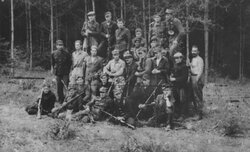 Self-Defense detachment in Volhynia in 1943. National Digital Archive.
Self-Defense detachment in Volhynia in 1943. National Digital Archive.
-
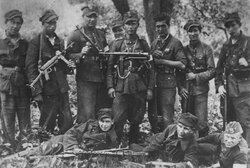 The squad of Corporal “Muszka” from the 27 Volhynian Infantry Division of the Home Army, 1944. Standing from left to right: Józef Rudzki “Korek,” Jakub Rudzki “Ołówek,” Szymon Koguciuk “Lew,” Zbigniew Wajs “Kula I,” Corp. Tadeusz Kański “Muszka,” Marian Tchórzewski “Śpioch,” Antoni Mordacz “Śmiały,” and Franciszek Iwańczuk “Bosman.” Lying from left to right: Józef Dobrzyński “Prędki,” Władysław Rudzki “Bomba,” and Jan Kostecki “Czarny.”
The squad of Corporal “Muszka” from the 27 Volhynian Infantry Division of the Home Army, 1944. Standing from left to right: Józef Rudzki “Korek,” Jakub Rudzki “Ołówek,” Szymon Koguciuk “Lew,” Zbigniew Wajs “Kula I,” Corp. Tadeusz Kański “Muszka,” Marian Tchórzewski “Śpioch,” Antoni Mordacz “Śmiały,” and Franciszek Iwańczuk “Bosman.” Lying from left to right: Józef Dobrzyński “Prędki,” Władysław Rudzki “Bomba,” and Jan Kostecki “Czarny.”
-
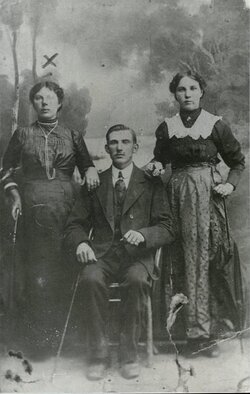 A family murdered on 7 November, 1943 in Witoldów. Materials from the files of an investigation conducted by the Lublin Branch of the Commission for the Prosecution of Crimes against the Polish Nation regarding the 1943 attacks of Ukrainian nationalists on Polish citizens in Witoldów in Volhynia.
A family murdered on 7 November, 1943 in Witoldów. Materials from the files of an investigation conducted by the Lublin Branch of the Commission for the Prosecution of Crimes against the Polish Nation regarding the 1943 attacks of Ukrainian nationalists on Polish citizens in Witoldów in Volhynia.
-
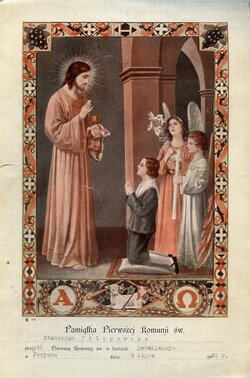 Stanisław Filipowicz’s first Holy Communion picture. Poryck, July 5, 1936. Piotr Filipowicz’s collection.
Stanisław Filipowicz’s first Holy Communion picture. Poryck, July 5, 1936. Piotr Filipowicz’s collection.
-
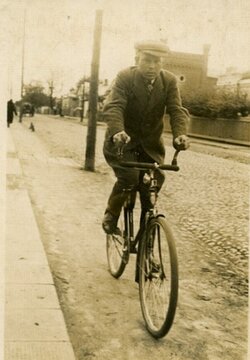 Adolf Filipowicz, Włodzimierz Wołyński, May 1, 1939. Piotr Filipowicz’s collection.
Adolf Filipowicz, Włodzimierz Wołyński, May 1, 1939. Piotr Filipowicz’s collection.
-
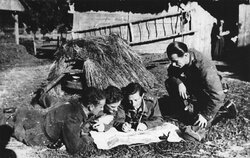 Soldiers of the 6th Company of the 27 Infantry Regiment of the Lvov Region of the Home Army. Officers studying a map in a backyard of a cottage. From left to right: 2nd Lt. Tadeusz Guzik “Uzda,” Lt. Walerian Proszowski “Józef,” Cpt. Zenon Kubski “Lech,” 2nd Lt. “Cwaniak.”
Soldiers of the 6th Company of the 27 Infantry Regiment of the Lvov Region of the Home Army. Officers studying a map in a backyard of a cottage. From left to right: 2nd Lt. Tadeusz Guzik “Uzda,” Lt. Walerian Proszowski “Józef,” Cpt. Zenon Kubski “Lech,” 2nd Lt. “Cwaniak.”
-
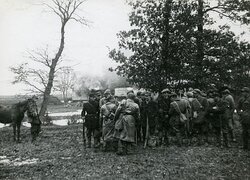 Sahryń, March 10, 1944, retaliation attack of the Tomaszów Lubelski AK Region on Ukrainian inhabitants of the village. Regional Museum in Tomaszów Lubelski. Photo No. 2
Sahryń, March 10, 1944, retaliation attack of the Tomaszów Lubelski AK Region on Ukrainian inhabitants of the village. Regional Museum in Tomaszów Lubelski. Photo No. 2
-
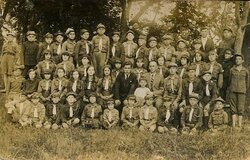 Scouts from Poryck during the interwar period. Piotr Filipowicz’s collection.
Scouts from Poryck during the interwar period. Piotr Filipowicz’s collection.
-
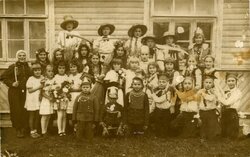 Most probably students of the school in Poryck, interwar period. Piotr Filipowicz’s collection.
Most probably students of the school in Poryck, interwar period. Piotr Filipowicz’s collection.
-
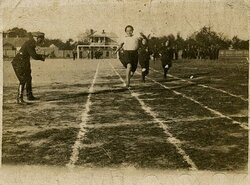 Sports competition, Poryck, interwar period. Piotr Filipowicz’s collection.
Sports competition, Poryck, interwar period. Piotr Filipowicz’s collection.
-
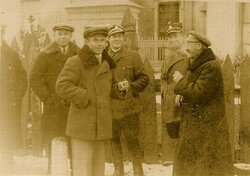 Most probably Poryck inhabitants, 1930s. Piotr Filipowicz’s collection.
Most probably Poryck inhabitants, 1930s. Piotr Filipowicz’s collection.
-
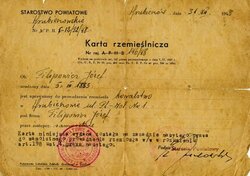 Craftsman’s card issued to Józef Filipowicz by the Hrubieszów County Office. After his escape from Poryck Józef Filipowicz settled in Hrubieszów.
Craftsman’s card issued to Józef Filipowicz by the Hrubieszów County Office. After his escape from Poryck Józef Filipowicz settled in Hrubieszów.
-
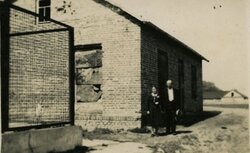 Poryck, June 10, 1943. Piotr Filipowicz’s collection.
Poryck, June 10, 1943. Piotr Filipowicz’s collection.
-
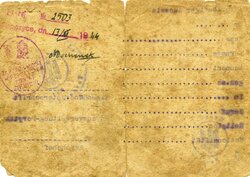 ID (Ausweiss) issued on February 1, 1943 to Józef Filipowicz domiciled in Poryck (Pawlice). The document was validated in March 1944 in Ropczyce in the Dębica county. Piotr Filipowicz’s collection (No. 1).
ID (Ausweiss) issued on February 1, 1943 to Józef Filipowicz domiciled in Poryck (Pawlice). The document was validated in March 1944 in Ropczyce in the Dębica county. Piotr Filipowicz’s collection (No. 1).
-
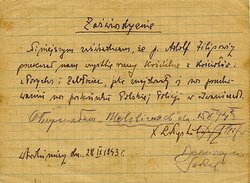 Certificate of September 1943 confirming Adolf Filipowicz’s donation to the churches in Poryck and Zabłocie. The donated objects were stored at the Polish Police station in Iwanicze. Piotr Filipowicz’s collection.
Certificate of September 1943 confirming Adolf Filipowicz’s donation to the churches in Poryck and Zabłocie. The donated objects were stored at the Polish Police station in Iwanicze. Piotr Filipowicz’s collection.
-
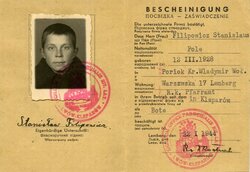 Certificate confirming Stanisław Filipowicz’s employement in the Lvov company called R.K. Pfarramt (Filipowicz survived the massacre the UPA conducted in Poryck on July 11, 1943). Piotr Filipowicz’s collection.
Certificate confirming Stanisław Filipowicz’s employement in the Lvov company called R.K. Pfarramt (Filipowicz survived the massacre the UPA conducted in Poryck on July 11, 1943). Piotr Filipowicz’s collection.
-
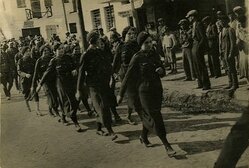 Parade of women doing military training in Poryck, 1930s. Piotr Filipowicz’s collection.
Parade of women doing military training in Poryck, 1930s. Piotr Filipowicz’s collection.
-
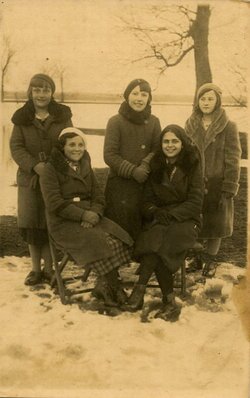 Poryck inhabitants, interwar period. Piotr Filipowicz’s collection.
Poryck inhabitants, interwar period. Piotr Filipowicz’s collection.
-
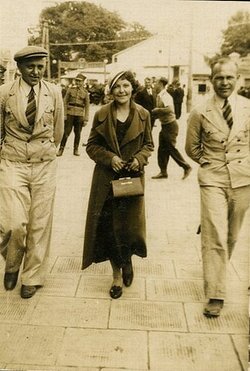 Adolf Filipowicz (on the right) on a street in Poryck, 1939. Piotr Filipowicz’s collection.
Adolf Filipowicz (on the right) on a street in Poryck, 1939. Piotr Filipowicz’s collection.
-
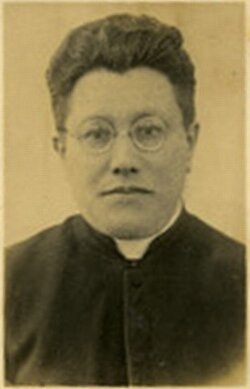 Father Bolesław Szawłowski - the last parish priest from the Poryck parish. He was killed on July 11, 1943 while celebrating a mass. Piotr Filipowicz’s collection.
Father Bolesław Szawłowski - the last parish priest from the Poryck parish. He was killed on July 11, 1943 while celebrating a mass. Piotr Filipowicz’s collection.
-
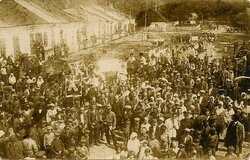 Inhabitants of Poryck (Pawliwka) - a small town in Włodzimierz Wołyński county, 1930s. Piotr Filipowicz’s collection.
Inhabitants of Poryck (Pawliwka) - a small town in Włodzimierz Wołyński county, 1930s. Piotr Filipowicz’s collection.
-
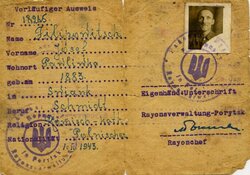 ID (Ausweiss) issued on February 1, 1943 to Józef Filipowicz domiciled in Poryck (Pawlice). The document was validated in March 1944 in Ropczyce in the Dębica county. Piotr Filipowicz’s collection (No. 2).
ID (Ausweiss) issued on February 1, 1943 to Józef Filipowicz domiciled in Poryck (Pawlice). The document was validated in March 1944 in Ropczyce in the Dębica county. Piotr Filipowicz’s collection (No. 2).
-
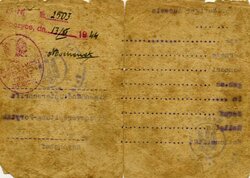 ID (Ausweiss) issued on February 1, 1943 to Józef Filipowicz domiciled in Poryck (Pawlice). The document was validated in March 1944 in Ropczyce in the Dębica county. Piotr Filipowicz’s collection (No. 3).
ID (Ausweiss) issued on February 1, 1943 to Józef Filipowicz domiciled in Poryck (Pawlice). The document was validated in March 1944 in Ropczyce in the Dębica county. Piotr Filipowicz’s collection (No. 3).
-
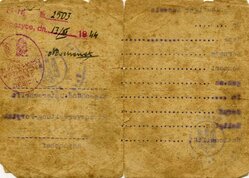 ID (Ausweiss) issued on February 1, 1943 to Józef Filipowicz domiciled in Poryck (Pawlice). The document was validated in March 1944 in Ropczyce in the Dębica county. Piotr Filipowicz’s collection (No. 4).
ID (Ausweiss) issued on February 1, 1943 to Józef Filipowicz domiciled in Poryck (Pawlice). The document was validated in March 1944 in Ropczyce in the Dębica county. Piotr Filipowicz’s collection (No. 4).
-
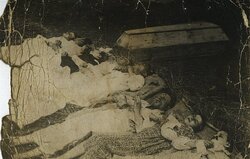 The family of Rudnicki murdered by the UPA in 1943 in the village of Chobułtowa in Włodzimierz Wołyński county (No. 2)
The family of Rudnicki murdered by the UPA in 1943 in the village of Chobułtowa in Włodzimierz Wołyński county (No. 2)
-
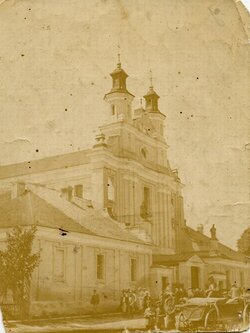 The parish church in Poryck during the interwar period. On July 11, 1943 a UPA conducted a massacre of Poryck inhabitants during a mass. There were only about a dozen survivors. Piotr Filipowicz’s collection.
The parish church in Poryck during the interwar period. On July 11, 1943 a UPA conducted a massacre of Poryck inhabitants during a mass. There were only about a dozen survivors. Piotr Filipowicz’s collection.
-
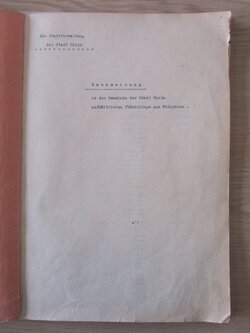 Documents of the Town of Chełm. No date, original title: „Nachweisung in der Gemeinde der Stadt Cholm aufhältlichen Flüchtlinge aus Wolhynien” (Census of the Volhynian population). It lists 1,578 names. No. 1
Documents of the Town of Chełm. No date, original title: „Nachweisung in der Gemeinde der Stadt Cholm aufhältlichen Flüchtlinge aus Wolhynien” (Census of the Volhynian population). It lists 1,578 names. No. 1
-
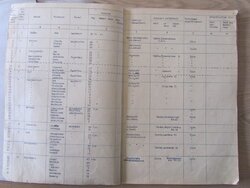 Files of the Town of Chełm. No date, original title: „Nachweisung in der Gemeinde der Stadt Cholm aufhältlichen Flüchtlinge aus Wolhynien” (Census of the Volhynian population). It lists 1,578 names. No. 2.
Files of the Town of Chełm. No date, original title: „Nachweisung in der Gemeinde der Stadt Cholm aufhältlichen Flüchtlinge aus Wolhynien” (Census of the Volhynian population). It lists 1,578 names. No. 2.
-
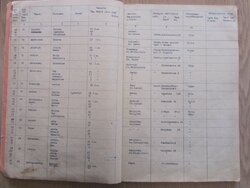 Files of the Town of Chełm. No date, original title: „Nachweisung in der Gemeinde der Stadt Cholm aufhältlichen Flüchtlinge aus Wolhynien” (Census of the Volhynian population). It lists 1,578 names. No. 3.
Files of the Town of Chełm. No date, original title: „Nachweisung in der Gemeinde der Stadt Cholm aufhältlichen Flüchtlinge aus Wolhynien” (Census of the Volhynian population). It lists 1,578 names. No. 3.
-
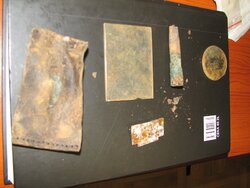 Objects retrieved during the exhumation of the mass grave in Wola Ostrowiecka conducted in August 1992. Leon Popek’s collection.
Objects retrieved during the exhumation of the mass grave in Wola Ostrowiecka conducted in August 1992. Leon Popek’s collection.
-
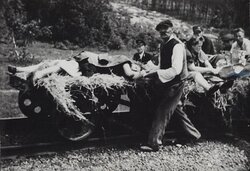 Victims of a UPA attack on a train conducted on June 16, 1944 near Zatyl (vicinity of Lubycza Królewska). Collection of the KARTA Center.
Victims of a UPA attack on a train conducted on June 16, 1944 near Zatyl (vicinity of Lubycza Królewska). Collection of the KARTA Center.
-
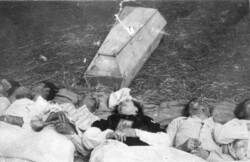 Chołopecze, Horochów county, Volhynia. The Czechs massacred by Ukrainians in the village of Chołopecze. Photographer unknown. Collection of the KARTA Center.
Chołopecze, Horochów county, Volhynia. The Czechs massacred by Ukrainians in the village of Chołopecze. Photographer unknown. Collection of the KARTA Center.
-
 December 1943, Latacz, Zaleszczyce county, Tarnopol voivodeship. The family of Karpiak massacred by the UPA on December 14, 1943: Maria Karpiak (mother, aged 42), Józef (son, aged 23); Genowefa (daughter, aged 20), Władysław (son, aged 18), Zofia (daughter, aged 8), and Zygmunt (son, aged 6). Photographer unknown, collection of the KARTA Center.
December 1943, Latacz, Zaleszczyce county, Tarnopol voivodeship. The family of Karpiak massacred by the UPA on December 14, 1943: Maria Karpiak (mother, aged 42), Józef (son, aged 23); Genowefa (daughter, aged 20), Władysław (son, aged 18), Zofia (daughter, aged 8), and Zygmunt (son, aged 6). Photographer unknown, collection of the KARTA Center.
-
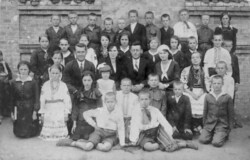 1931, Basów Kąt, Równe county, Volhynia. Employees and students of the elementary school. The boys sitting in front are Tadeusz Walik (on the left) and S. Krawczuk (on the right). Teachers from left to right: Jakub Głodek, headmaster’s wife, and headmaster W. Romanowski. Four of the students are children of military settlers, whereas the rest of the children are Ukrainians. Collection of the KARTA Center.
1931, Basów Kąt, Równe county, Volhynia. Employees and students of the elementary school. The boys sitting in front are Tadeusz Walik (on the left) and S. Krawczuk (on the right). Teachers from left to right: Jakub Głodek, headmaster’s wife, and headmaster W. Romanowski. Four of the students are children of military settlers, whereas the rest of the children are Ukrainians. Collection of the KARTA Center.
-
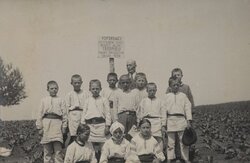 1934, Toporowce, Horodenka county, Stanisławów voivodeship. Children at a Farming Course. The inscription in Polish and Ukrainian reads: \
1934, Toporowce, Horodenka county, Stanisławów voivodeship. Children at a Farming Course. The inscription in Polish and Ukrainian reads: \
-
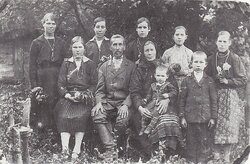 The family of Jasionczak from Wola Ostrowiecka. Sitting from left to right: Helena (daughter, married), Paweł (father), and Józefa (mother) with her grandson Jan. Standing from left to right: Franciszka (daughter), Anastazja (daughter), Stanisław (son), and Marianna. The whole family died. Leon Popek’s collection.
The family of Jasionczak from Wola Ostrowiecka. Sitting from left to right: Helena (daughter, married), Paweł (father), and Józefa (mother) with her grandson Jan. Standing from left to right: Franciszka (daughter), Anastazja (daughter), Stanisław (son), and Marianna. The whole family died. Leon Popek’s collection.
-
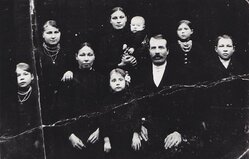 The family of Szwed (pseudonym “Dziki”) from Wola Ostrowiecka. Left to right: Karolina (died in Wola Ostrowiecka), Marianna (died with her husband), Wincentyna, Anastazja, Anna (died with her five children), Michał (died in Wola Ostrowiecka), and Jadwiga.
The family of Szwed (pseudonym “Dziki”) from Wola Ostrowiecka. Left to right: Karolina (died in Wola Ostrowiecka), Marianna (died with her husband), Wincentyna, Anastazja, Anna (died with her five children), Michał (died in Wola Ostrowiecka), and Jadwiga.
-
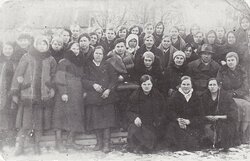 Course for the board of the Village Women’s Club in Luboml, February 22, 1937. First row: Julia Jesionczak (neé Bednarz, sitting first on the left), Jadwiga Strażyc (standing second on the left), Jadwiga Teleżyńska (tenth from the left). Women standing in the last row: Anastazja Szwed (fifth from the right), Jadwiga Kloc (sixth from the right), Maria Trusiuk (seventh from the right), Aleksandra Pogorzelec (eighth from the right), and Anastazja Szwed (ninth from the right). Leon Popek’s collection.
Course for the board of the Village Women’s Club in Luboml, February 22, 1937. First row: Julia Jesionczak (neé Bednarz, sitting first on the left), Jadwiga Strażyc (standing second on the left), Jadwiga Teleżyńska (tenth from the left). Women standing in the last row: Anastazja Szwed (fifth from the right), Jadwiga Kloc (sixth from the right), Maria Trusiuk (seventh from the right), Aleksandra Pogorzelec (eighth from the right), and Anastazja Szwed (ninth from the right). Leon Popek’s collection.
-
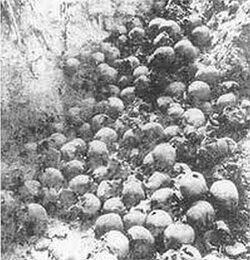 Remains of the victims from Ostrówki and Wola Ostrowiecka retrieved during the exhumation of the mass graves in August 1992. Leon Popek’s collection.
Remains of the victims from Ostrówki and Wola Ostrowiecka retrieved during the exhumation of the mass graves in August 1992. Leon Popek’s collection.
-
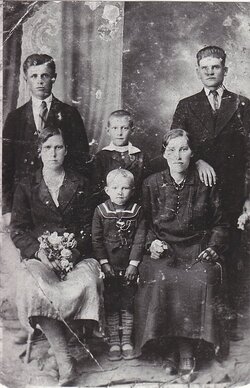 The family of Pradun from Ostrówki. Sitting from right to left: Maria (died near Sokal), Aleksander, and Maria’s sister (died near Sokół). Standing from right to left: Jan (Maria’s husband), Stanisław (died near Sokół), and Maria’s sister’s husband. Leon Popek’s collection.
The family of Pradun from Ostrówki. Sitting from right to left: Maria (died near Sokal), Aleksander, and Maria’s sister (died near Sokół). Standing from right to left: Jan (Maria’s husband), Stanisław (died near Sokół), and Maria’s sister’s husband. Leon Popek’s collection.
-
